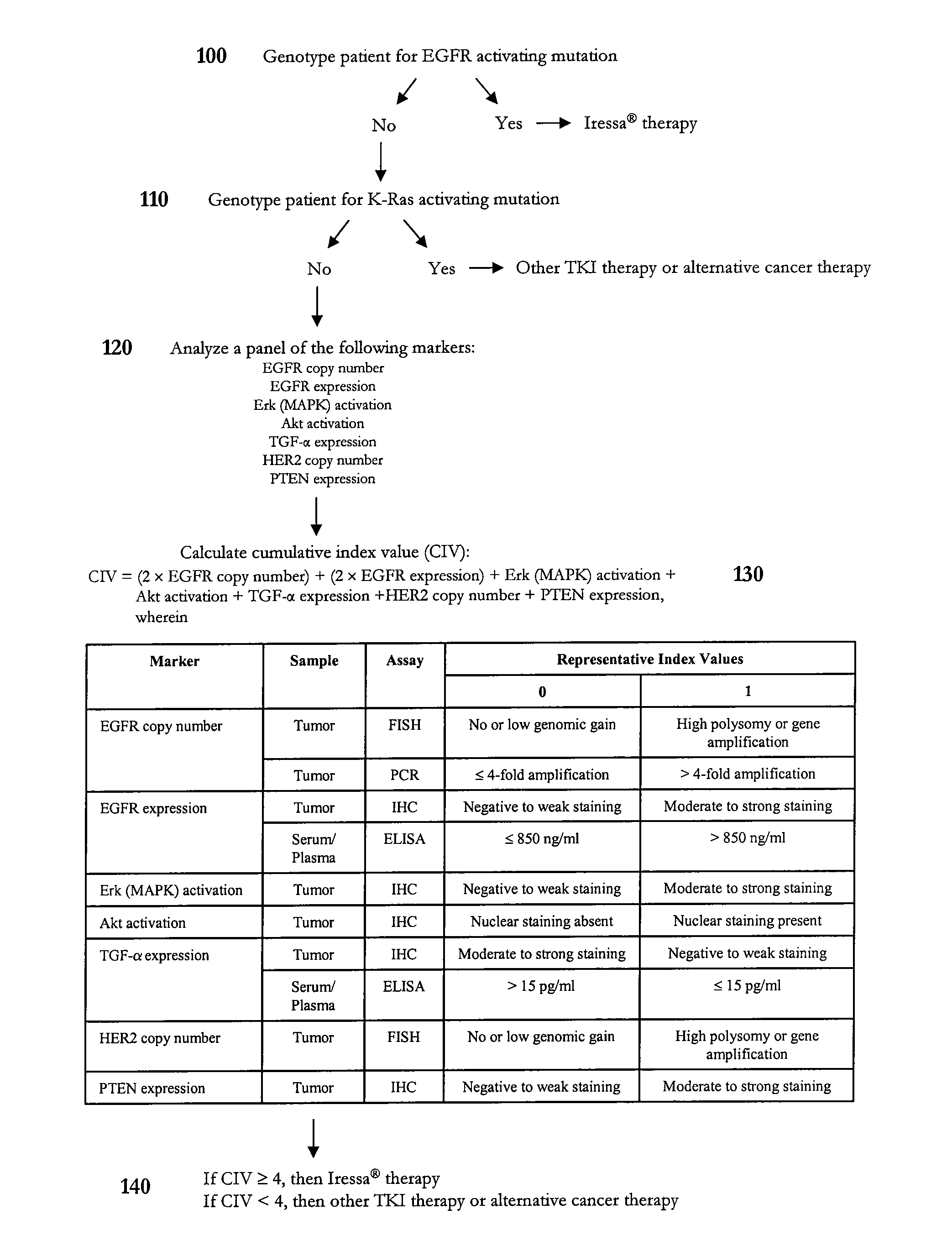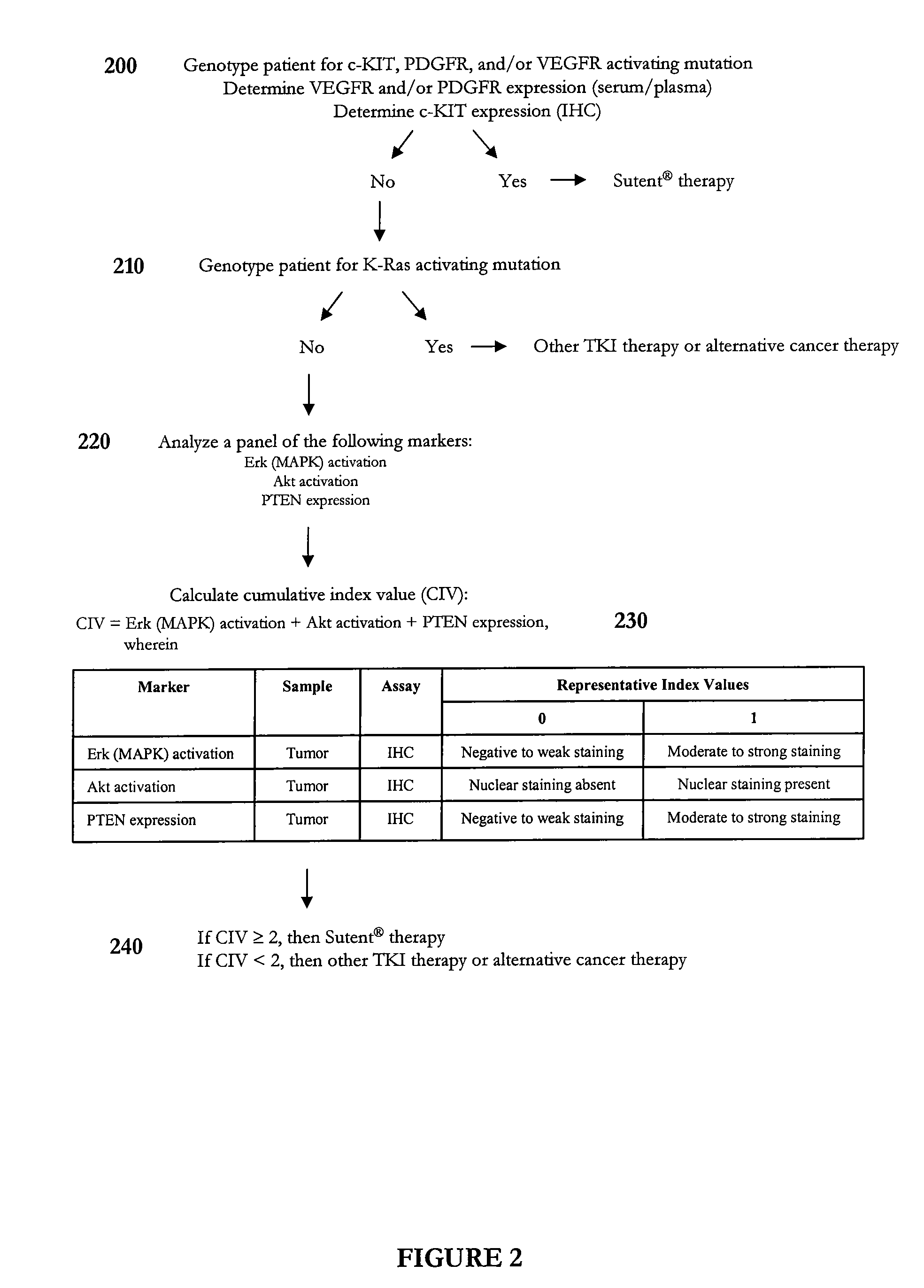Methods of predicting and monitoring tyrosine kinase inhibitor therapy
a tyrosine kinase inhibitor and tyrosine kinase technology, applied in the field of methods of predicting and monitoring tyrosine kinase inhibitor therapy, can solve the problems of malignant transformation, cell surface increases the incidence of receptor dimerization, and deregulation of tyrosine kinase activity, so as to reduce toxic side effects
- Summary
- Abstract
- Description
- Claims
- Application Information
AI Technical Summary
Benefits of technology
Problems solved by technology
Method used
Image
Examples
example 1
Algorithm for Predicting Response to Gefitinib (Iressa®) Therapy
[0243] This example illustrates an algorithm that was developed to predict response to gefitinib therapy. In particular, a representative panel of genetic, serological, and biochemical tests was performed on tumor, plasma, and / or serum samples to calculate a cumulative index value for a subject diagnosed with a solid tumor such as non-small cell lung cancer. In this example, representative index values predictive of gefitinib sensitivity were assigned a value of 1. However, one skilled in the art will appreciate that the index values need not be integers. The final individual profile assessment can be presented as a cumulative index value, which represents a summation of the representative index values determined for each biomarker. In certain instances, one or more biomarkers can have a weighted representative index value.
[0244] As shown in FIG. 1, a subject diagnosed with a cancer such as non-small cell lung cancer ...
example 2
Algorithm for Predicting Response to Sunitinib (Sutent®) Therapy
[0247] This example illustrates an algorithm that was developed to predict response to sunitinib therapy. In particular, a representative panel of genetic, serological, and biochemical tests was performed on tumor, plasma, and / or serum samples to calculate a cumulative index value for a subject diagnosed with a solid tumor such as a gastrointestinal stromal tumor or renal cell carcinoma. In this example, representative index values predictive of sunitinib sensitivity were assigned a value of 1. However, one skilled in the art will appreciate that the index values need not be integers. The final individual profile assessment can be presented as a cumulative index value, which represents a summation of the representative index values determined for each biomarker. In certain instances, one or more biomarkers can have a weighted representative index value.
[0248] As shown in FIG. 2, a subject diagnosed with a cancer such ...
example 3
Biomarker Analysis in Fractionated Whole Blood
[0251] This example illustrates the use of fractionated whole blood for determining a spectrum of profiles including a genotypic profile, gene copy number profile, gene expression profile, DNA methylation profile, protein expression profile, protein activation profile, and combinations thereof. Whole blood which has been separated into its liquid and cellular components can also be used for determining the localization of proteinaceous biomarkers of interest, the morphology of cells of interest, and the number of circulating tumor and / or endothelial cells in a subject diagnosed with a solid tumor.
[0252] Circulating tumor and / or endothelial cells can act as a surrogate for biomarker analysis of the primary or metastatic tumor. In addition to releasing intact viable cells into the circulation, tumors also release freely circulating DNA, RNA, and shed proteins at levels that can be analyzed with current technologies. By segregating a whol...
PUM
| Property | Measurement | Unit |
|---|---|---|
| Digital information | aaaaa | aaaaa |
| Digital information | aaaaa | aaaaa |
| Digital information | aaaaa | aaaaa |
Abstract
Description
Claims
Application Information
 Login to View More
Login to View More - R&D
- Intellectual Property
- Life Sciences
- Materials
- Tech Scout
- Unparalleled Data Quality
- Higher Quality Content
- 60% Fewer Hallucinations
Browse by: Latest US Patents, China's latest patents, Technical Efficacy Thesaurus, Application Domain, Technology Topic, Popular Technical Reports.
© 2025 PatSnap. All rights reserved.Legal|Privacy policy|Modern Slavery Act Transparency Statement|Sitemap|About US| Contact US: help@patsnap.com



